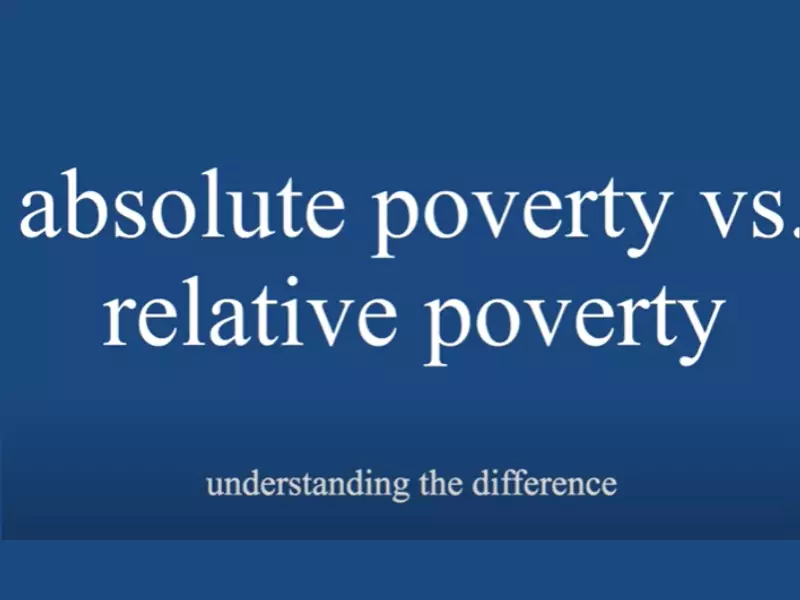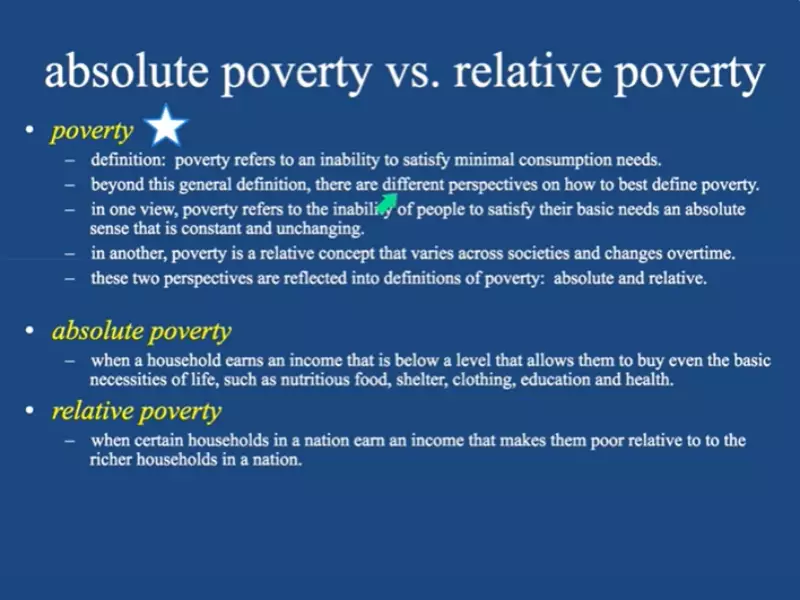Poverty is a multifaceted phenomenon that affects billions of lives globally, manifesting in lack of access to basic needs such as food, clean water, and shelter. While the term ‘poverty’ is universally recognized, its types, such as absolute and relative poverty, are often misunderstood or used interchangeably. Understanding the distinctions between these types is crucial for developing effective policies and interventions to combat poverty.
The difference between relative poverty and absolute poverty lies in their measurement and implications. Absolute poverty refers to a condition where individuals cannot meet the minimum standards of living, quantified by the inability to afford basic needs such as food, shelter, and healthcare. In contrast, relative poverty measures economic inequality, defined as a condition where a person’s income is significantly lower than the average income of the society they live in, impacting their ability to maintain a standard of living that is considered normal in that society.
While absolute poverty focuses on survival, relative poverty emphasizes social inclusion and equality. Both concepts are critical for understanding the global poverty landscape, influencing policy-making, and directing aid and development efforts. Recognizing the nuances between absolute and relative poverty enables a comprehensive approach to addressing the broader issues of economic disparity, social justice, and human dignity.

Poverty Basics
Definition of Poverty
Poverty is a state where individuals or communities lack the financial resources to meet basic living standards, including food, shelter, and healthcare. It’s a complex issue that affects millions worldwide, influencing not just individual lives but entire societies.
Key Poverty Indicators
To grasp the extent and impact of poverty, certain indicators are widely used:
- Income levels: A critical metric, often defining poverty in terms of earning below a certain income threshold.
- Access to services: This includes healthcare, education, and sanitation, highlighting the multidimensional nature of poverty.
Absolute Poverty
Absolute Poverty Explained
Absolute poverty is defined as living below a certain income threshold that is considered the minimum necessary to maintain basic living standards. This concept focuses on survival.
Definition and criteria
The criteria for absolute poverty include the inability to afford basic needs such as food, shelter, and clean water.
Measuring Absolute Poverty
The process of measuring absolute poverty involves:
- Poverty threshold: A specific dollar amount considered the minimum necessary to live. This threshold varies by country but aims to reflect the cost of basic living needs.
- International standards: Organizations like the World Bank set global benchmarks, such as living on less than $1.90 a day, to measure poverty across different countries.
Impact of Absolute Poverty
The effects of living in absolute poverty are severe and far-reaching:
- Health: Limited access to healthcare and nutritious food leads to higher rates of diseases and lower life expectancy.
- Education: Financial constraints often mean limited access to education, affecting literacy and employment opportunities.
- Living conditions: Poor living conditions, including inadequate housing and lack of clean water, are prevalent among those in absolute poverty.
Relative Poverty
Relative Poverty Explained
Relative poverty differs from absolute poverty by measuring economic status in relation to the broader society one lives in. It focuses on the ability to participate in normal societal activities and access opportunities.
Definition and contextuality
This form of poverty is context-specific, varying greatly from one country to another based on societal standards and average incomes.
Measuring Relative Poverty
Key aspects of measuring relative poverty include:
- Percentage of median income: Typically, individuals earning less than 50% of their country’s median income are considered to be living in relative poverty.
- Variability by country and region: What constitutes relative poverty can differ greatly depending on local economic conditions and societal norms.
Impact of Relative Poverty
Relative poverty impacts individuals and communities in various ways:
- Social exclusion: Those in relative poverty often face barriers to social participation, leading to isolation.
- Economic disparities: Relative poverty underscores the growing gap between the wealthy and the poor within societies.
- Psychological effects: The stigma and stress associated with relative poverty can have profound psychological impacts.
Comparative Analysis
Key Differences
When comparing absolute and relative poverty, several distinctions stand out:
- Basis of measurement: Absolute poverty is measured against a fixed standard, while relative poverty is measured in relation to the average standards of a society.
- Context sensitivity: Relative poverty is sensitive to societal changes and economic conditions, unlike absolute poverty which is based on survival needs.
Similarities
Despite their differences, absolute and relative poverty share some common ground:
- Overlapping challenges: Both forms of poverty entail significant hardships, including limited access to essential services and opportunities.
- Policy implications: Addressing both requires comprehensive strategies that include economic policies, social services, and targeted aid.

Global Poverty Trends
Progress and Challenges
The fight against poverty has seen significant progress over the past few decades, with a dramatic reduction in absolute poverty globally. Advances in technology, international aid, and economic development have lifted millions out of extreme conditions. However, challenges remain, especially in terms of relative poverty, which persists and even grows in some regions due to inequality and economic stagnation.
Reduction in Absolute Poverty
Since the late 20th century, global efforts have resulted in substantial decreases in the number of people living in absolute poverty. Key factors contributing to this success include:
- Improved access to education and healthcare, leading to better employment opportunities and healthier lives.
- Economic growth in developing countries, particularly in Asia, has been a major driver in reducing poverty levels.
Despite these achievements, absolute poverty remains a critical issue in many parts of Africa and Asia, requiring continued focus and action.
Persistence of Relative Poverty
While absolute poverty has decreased, relative poverty remains a stubborn challenge in both developed and developing countries. Factors contributing to its persistence include:
- Income inequality within countries, where the wealth gap between the richest and poorest grows.
- Economic policies that fail to address the needs of the lower-income segments of the population.
This highlights the need for policies that not only focus on economic growth but also ensure that the benefits of growth are shared equitably across society.
Future Outlook
Looking forward, the Sustainable Development Goals (SDGs) set by the United Nations offer a comprehensive framework for addressing both absolute and relative poverty. Achieving these goals requires a concerted effort from governments, the private sector, and civil society.
Sustainable Development Goals (SDGs)
The SDGs aim to eradicate poverty in all its forms by 2030. Key goals include:
- Ensuring universal access to basic services such as education, healthcare, and sanitation.
- Promoting sustainable economic growth, with a focus on jobs and livelihoods that can lift people out of poverty.
Role of International Cooperation
International cooperation plays a vital role in poverty reduction, through:
- Financial aid and investment in development projects.
- Sharing of knowledge and best practices between countries.
- Global partnerships that align efforts and resources towards common goals.
Addressing Poverty
Strategies for Absolute Poverty
Addressing absolute poverty requires targeted interventions that address the immediate needs of those living below the poverty line.
Direct Aid
Direct aid remains a crucial strategy for providing immediate relief to those in dire need. This includes:
- Food aid to prevent hunger and malnutrition.
- Emergency healthcare services to address preventable diseases.
- Provision of shelter and basic necessities for those displaced by conflict or natural disasters.
Economic Development
Long-term strategies for eradicating absolute poverty focus on stimulating economic development, including:
- Investment in infrastructure to improve access to markets, increase productivity, and create jobs.
- Support for small and medium-sized enterprises (SMEs) as engines of economic growth and employment.
- Education and skill development programs to improve workforce employability.
Strategies for Relative Poverty
Tackling relative poverty involves addressing broader issues of inequality and ensuring that economic growth benefits all segments of society.
Social Policies
Effective social policies are essential for reducing relative poverty, such as:
- Universal healthcare and education systems that ensure equal access for all.
- Social safety nets, including unemployment benefits and pension schemes, to protect against economic shocks.
Income Redistribution
Income redistribution policies can help to reduce economic disparities, including:
- Progressive taxation systems where the wealthy pay a higher proportion of their income in taxes.
- Public spending on services and infrastructure that disproportionately benefits poorer communities.
- Minimum wage laws and labor protections to ensure fair compensation for work.
Frequently Asked Questions
What Causes Poverty?
Poverty stems from a combination of factors including economic downturns, lack of education, political instability, social discrimination, and natural disasters. Systemic issues such as inequality and lack of access to resources also play significant roles.
How Can Poverty Be Reduced?
Reducing poverty requires multifaceted approaches including economic development, education, improved healthcare, social safety nets, and policies aimed at increasing access to resources and opportunities for the underprivileged.
What Is the Poverty Line?
The poverty line is a monetary threshold below which an individual or family is considered to be living in poverty. It varies by country and is used to measure and compare levels of poverty within and across nations.
How Does Poverty Affect Education?
Poverty significantly impacts education by limiting access to learning materials, educational facilities, and opportunities. Children from impoverished backgrounds are more likely to experience disruptions in schooling and lower academic achievement.
Conclusion
Understanding the difference between relative and absolute poverty is pivotal in crafting effective strategies to combat poverty. While absolute poverty measures the basic needs for survival, relative poverty focuses on an individual’s ability to participate in societal norms and activities. This distinction is not just academic but practical, guiding targeted interventions that address the diverse manifestations of poverty.
Efforts to alleviate poverty must therefore be multi-dimensional, addressing both the urgent needs of those living in absolute poverty and the broader issues of inequality and exclusion signified by relative poverty. Through a combination of direct aid, policy reform, and sustainable development, we can move closer to a world where poverty in all its forms is eradicated.
